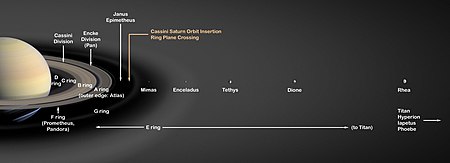စနေဂြိုဟ်၏ ဂြိုဟ်ရံလများ
စနေဂြိုဟ်၏ ဂြိုဟ်ရံလများ များသည် များပြား ကွဲပြားကြပြီး[၁] ၁ ကီလိုမီတာအောက် ငယ်သော လကလေး (moonlet) မှသည် မာကျူရီဂြိုဟ်ထက် ပိုကြီးသည့် တိုက်တန်အထိ ရှိကြသည်။ စနေဂြိုဟ်၌ အတည်ပြုပြီး ဂြိုဟ်ပတ်လမ်းကြောင်းရှိ ဂြိုဟ်ရံလပေါင်း ၈၃ စင်းရှိပြီး[၂] ကျန်သော ၅၃ စင်းမှာမူ အမည်သတ်မှတ်ထားသော်လည်း ၁၃ စင်းမှာ ၅၀ ကီလိုမီတာကျော်ခန့်သာ ကြီးမားကြသည်။ ယင်းတို့၏ ပတ်လမ်းကြောင်းများသည် ရှုပ်ထွေးလှသည်။[၃][၄] စနေဂြိုဟ်၏ သိသာထင်ရှားသော ဂြိုဟ်ရံလများမှာ တိုက်တန်ဖြစ်ပြီး ဂျူပီတာဂြိုဟ်၏ ဂျန်နမိတ်ပြီးလျင် နေအဖွဲ့အစည်း၌ ဒုတိယအကြီးဆုံး လတစ်စင်းဖြစ်သည်။ ယင်းဂြိုဟ်ရံလတွင် နိုက်ထရိုဂျင်ကြွယ်ဝသည့် ကမ္ဘာမြေကဲ့သို့ လေထုတည်ရှိပြီး မြစ်ချောင်းများကဲ့သို့ မြေမျက်နှာသွင် တည်ရှိကာ ဟိုက်ဒရိုကာဗွန် အင်းအိုင် တည်ရှိသည်။ ဤကဲ့သို့သော သွင်ပြင်လက္ခဏာများကို နေအဖွဲ့အစည်း၏ မည်သည့်နေရာတွင်မှ မတွေ့ရပေ။[၅] အန်ဆဲလ်ဒပ်စ် ၏ ဓာတုဖွဲ့စည်းပုံမှာ ကြယ်တံခွန်များ၏ ဓာတုဖွဲ့စည်းပုံနှင့် ဆင်တူသည်။[၆] အန်ဆဲလ်ဒပ်စ်သည် ဓာတ်ငွေ့နှင့် ဖုန်မှုန်များကို ပန်းထုတ်နေသောကြောင့် တောင်ဝင်ရိုးစွန်းဒေသ၏ အောက်ခြေ၌ ရေတည်ရှိသည်ဆိုသည်အား ညွန်ပြနေသည်။ ယင်းအချက်သည် မြေမျက်နှာပြင်အောက်ခြေ၌ သမုဒ္ဒရာ တည်ရှိနိုင်ကောင်း၏။[၇]
စနေဂြိုဟ်၏ ဂြိုဟ်ရံလ ၂၄ စင်းသည် ပုံမှန် ဂြိုဟ်ရံလများဖြစ်ပြီး[၈] ကျန်သော ၅၈ စင်းမှာ ပုံမှန်မဟုတ်သော ဂြိုဟ်ရံလများ ဖြစ်ကြသည်။
ကိုးကား
[ပြင်ဆင်ရန်]- ↑ Corum၊ Jonathan။ "Mapping Saturn’s Moons"၊ New York Times၊ December 18, 2015။ December 18, 2015 တွင် ပြန်စစ်ပြီး။
- ↑ Planetary Satellite Discovery Circumstances။ Jet Propulsion Laboratory (15 November 2021)။ 28 March 2022 တွင် ပြန်စစ်ပြီး။
- ↑ Solar System Exploration Planets Saturn: Moons: S/2009 S1။ NASA။ January 17, 2010 တွင် ပြန်စစ်ပြီး။
- ↑ Sheppard, Scott S.။ The Giant Planet Satellite and Moon Page။ Departament of Terrestrial Magnetism at Carniege Institution for science။ 2008-08-28 တွင် ပြန်စစ်ပြီး။
- ↑ Titan: Facts About Saturn's Largest Moon။
- ↑ Battersby၊ Stephen (March 26, 2008)။ Saturn's moon Enceladus surprisingly comet-like။ New Scientist။ April 16, 2015 တွင် ပြန်စစ်ပြီး။
- ↑ Enceladus - Overview - Planets - NASA Solar System Exploration။ 2013-02-17 တွင် မူရင်းအား မော်ကွန်းတင်ပြီး။
- ↑ Moons။ 20 April 2013 တွင် မူရင်းအား မော်ကွန်းတင်ပြီး။ 27 July 2018 တွင် ပြန်စစ်ပြီး။



